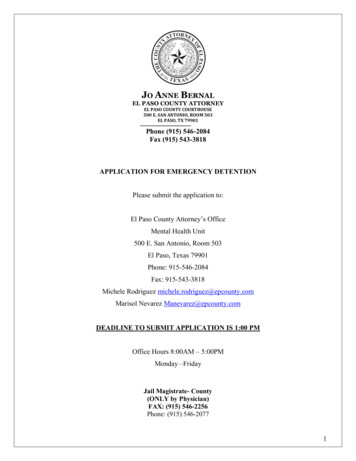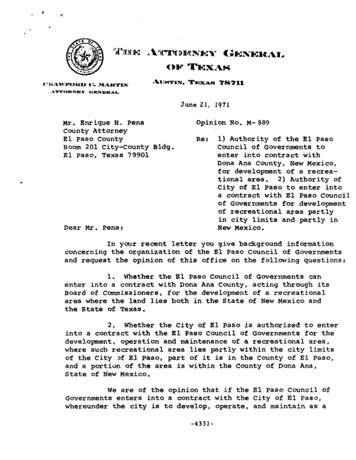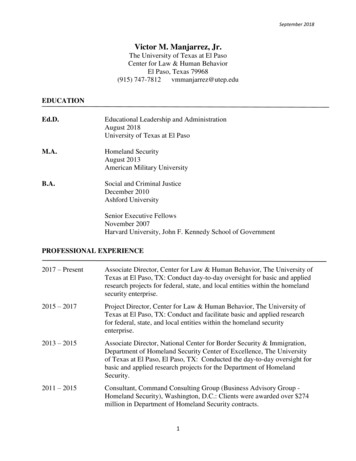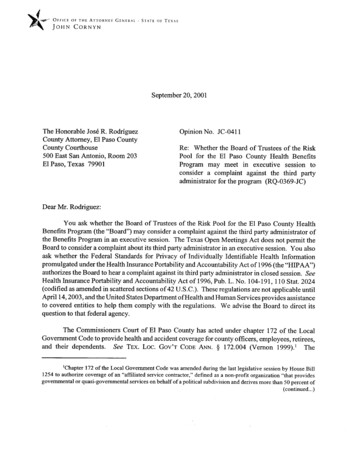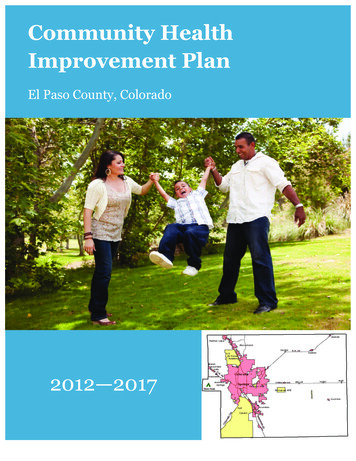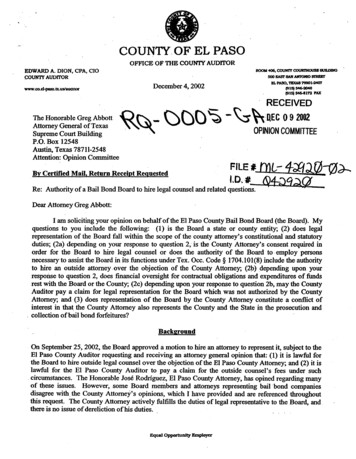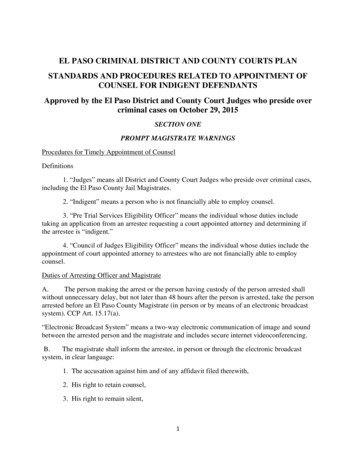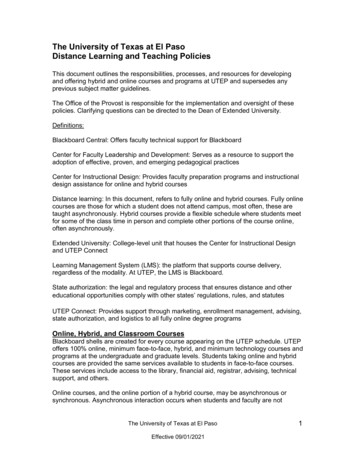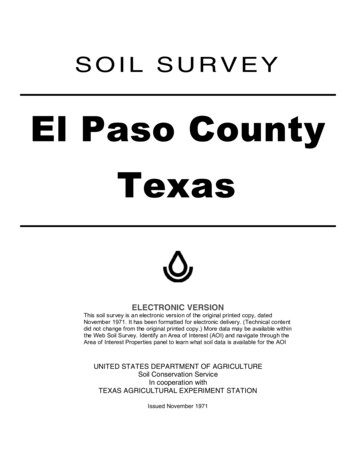
Transcription
SOIL SURVEYEl Paso CountyTexasELECTRONIC VERSIONThis soil survey is an electronic version of the original printed copy, datedNovember 1971. It has been formatted for electronic delivery. (Technical contentdid not change from the original printed copy.) More data may be available withinthe Web Soil Survey. Identify an Area of Interest (AOI) and navigate through theArea of Interest Properties panel to learn what soil data is available for the AOIUNITED STATES DEPARTMENT OF AGRICULTURESoil Conservation ServiceIn cooperation withTEXAS AGRICULTURAL EXPERIMENT STATIONIssued November 1971
Soil Survey of El Paso County, TexasiiMajor fieldwork for this soil survey was completed in the period 1960-66. Soil names anddescriptions were approved in 1967. Unless otherwise indicated, statements in this publicationrefer to conditions in the county in 1967. This survey was made cooperatively by the SoilConservation Service and the Texas Agricultural Experiment Station. It is part of the technicalassistance furnished to the El Paso-Hudspeth Soil Conservation District.Either enlarged or reduced copies of the soil map in this publication can be made bycommercial photographers, or they can be purchased on individual order from the CartographicDivision, Soil Conservation Service, United States Department of Agriculture, Washington, D.C.20250HOW TO USE THIS SOIL SURVEYThis soil survey contains information that can be applied in managing farms andranches; in selecting sites for roads, ponds, buildings, and other structures; and indetermining the suitability of tracts of land for farming, industry, and recreation.Locating SoilsAll the soils of El Paso County are shown on the detailed map at the back of thispublication. This map consists of many sheets made from aerial photographs. Eachsheet is numbered to correspond with a number on the Index to Map Sheets.On each sheet of the detailed map, soil areas are outlined and are identified bysymbols. All areas marked with the same symbol are the same kind of soil. The soilsymbol is inside the area if there is enough room; otherwise, it is outside, and apointer shows where the symbol belongs.Finding and Using InformationThe “Guide to Mapping Units (Removed)” can be used to find information. Thisguide lists all the soils of the county in alphabetic order by map symbol and gives thecapability classification of each. It also shows the page where each soil is describedand the page for the range site in which the soil has been placed.Individual colored maps showing the relative suitability or degree of limitation ofsoils for many specific purposes can be developed by using the soil map and theinformation in the text. Translucent material can be used as an overlay over the soilmap and colored to show soils that have the same limitation or suitability. Forexample, soils that have a slight limitation for a given use can be colored green;those with a moderate limitation can be colored yellow; and those with a severelimitation can be colored red.Farmers and those who work with farmers can learn about use and managementof the soils from the soil descriptions and from the discussions of capability units andrange sites.Ranchers and others can find, under “Description of the Soils,” discussions of thesoils according to their suitability for range, and also the names of many of the plantsthat grow on each soil. In addition, ranchers and others will find information aboutrangeland in the section “Range Sites and Condition Classes.”Community planners and others can read about soil properties that affect thechoice of sites for nonindustrial buildings and for recreation areas in the section“Community Development.”Engineers and builders can find, under “Engineering Uses of Soils,” tables thatcontain test data, estimates of soil properties, and information about soil features thataffect engineering practices.Scientists and others can read about how the soils were formed and how they areclassified in the section “Formation and Classification of the Soils.”Newcomer in El Paso County may be especially interested in the section“General Soil Map,” where broad patterns of soils are described. They also may beinterested in the section “Additional Facts About the County.”
Soil Survey of El Paso County, TexasContentsPageHow this survey was made .2General soil map .3Hueco-Wink association.3Bluepoint association.4Harkey-Glendale association.6Delnorte-Canutio association .7Wink-Simona-Mimbres association .8Limestone rock land-Lozier association .9Turney-Berino association.9Igneous rock land-Limestone rockland association . 10Descriptions of the soils. 11High-intensity survey . 13Anapra series . 13Brazito series . 14Gila series . 15Glendale series . 17Harkey series . 20Made land, Gila soil material. 22Saneli series. 23Tigua series . 25Vinton series . 27Low-intensity survey . 29Agustin series. 29Badlands . 31Berino series . 31Bluepoint series . 32Brewster series. 34Canutio series . 35Delnorte series . 36Dune land . 38Hueco series . 38Igneous rock land . 40Igneous rock land-Brewster association . 41Limestone rock land-Lozier association . 42Lozier series. 43Mimbres series . 44Pajarito series . 45Simona series . 47Turney series . 48Wink series . 51Interpreting soils by capability classification . 52Predictions of crop yields. 55Range sites and condition classes . 55Engineering uses of soils . 56Engineering classification systems . 57Engineering test data. . 58Estimated engineering properties. 58Engineering interpretations of the soils . 59Community development. 59Use of soils in community development . 60iii
Soil Survey of El Paso County, TexasFormation and classification of soils. 61Formation of soils . 61Parent material . 62Climate . 62Plant and animal life. 63Relief . 63Time . 63Classification of soils . 63Additional facts about the county. 64Climate . 64Relief and drainage . 65Farming . 66Literature cited . 66Glossary . 67Guide to mapping units . RemovedIssued November 1971iv
Soil Survey of El Paso County, Texas1SOIL SURVEY OF EL PASO COUNTY, TEXASBY HUBERT B. JACOFIELD SURVEY BY HUBERT B. JACO AND LARRY M. LOCKWOOD, SOIL CONSERVATIONSERVICEUNITED STATES DEPARTMENT OF AGRICULTURE IN COOPERATION WITH THE TEXASAGRICULTURAL EXPERIMENT STATIONEL PASO COUNTY is in the far western tip of Texas (fig. 1). It is bordered byHudspeth County on the east, the State of New Mexico on the west and north,and the State of Chihuahua, Mexico, on the south. The total area of thecounty is about 1,057 square miles or 676,683 acres. Prior to the Chamizal Treatywith Mexico in 1964, the total area was 677,120 acres. The county is shaped roughlylike a right triangle; it extends about 55 miles from northwest to southeast and, at itswidest, part, about 35 miles from west to east.The average annual rainfall in the county is only 7.89 inches. Under irrigation,crops are grown on about 70,000 acres, mostly on the flood plain of the Rio Grande.Water for irrigation is obtained mainly from the Elephant Butte Dam-Rio GrandeProject. The principal crop grown is cotton, both upland and Pima (also calledEgyptian). Alfalfa is another important crop, and smaller acreages are used for smallgrains, grain sorghum, vegetable crops, sudangrass, pecans, and irrigated pasture.The Far West Texas Research Station of Texas Agricultural and MechanicalUniversity is in El Paso County.Figure 1.—Location of El Paso County, Texas.
Soil Survey of El Paso County, Texas2How This Survey Was MadeSoil scientists made this survey to learn what kinds of soil are in El Paso County,where they are located, and how they can be used. The soil scientists went into thecounty knowing they likely would find many soils they had already seen and perhapssome they had not. As they traveled over the county, they observed the steepness,length, and shape of slopes, the size and speed of streams, the kinds of native plantsor crops, the kinds of rock, and many facts about the soils. They dug many holes toexpose soil profiles. A profile is the sequence of natural layers, or horizons, in a soil;it extends from the surface down into the parent material that has not, been changedmuch by leaching or by the action of plant roots.The soil scientists made comparisons among tile profiles they studied, and theycompared these profiles with those in counties nearby and in places more distant.They classified and named the soils according to nationwide, uniform procedures.The soil series and the soil phase are the categories of soil classification most usedin a local survey.Soils that have profiles almost alike make up a soil series. Except for differenttexture in the surface layer, all the soils of one series have major horizons that aresimilar in thickness, arrangement, and other important characteristics. Each soilseries is named for a town or other geographic feature near the place where a soil ofthat series was first observed and mapped. Gila and Hueco, for example, are thenames of two soil series. All the soils in the United States having the same seriesname are essentially alike in those characteristics that affect their behavior in theundisturbed landscape.Soils of one series can differ in texture of the surface soil and in slope, stoniness,or some other characteristic that affects use of the soils by man. On the basis of suchdifferences, a soil series is divided into phases. The name of a soil phase indicates afeature that affects management. For example, Glendale loam is one of severalphases within the Glendale series.After a guide for classifying and naming the soils has been worked out, the soilscientists drew the boundaries of the individual soils on aerial photographs. Thesephotographs show roads, buildings, field borders, canals, and other details that helpin drawing boundaries accurately. The soil map in the back of this publication wasprepared from the aerial photographs.The areas shown on a soil map are called mapping units. On most maps detailedenough to be useful in planning the management of farms and fields, a mapping unitis nearly equivalent to a soil phase. It is not exactly equivalent, because it is notpractical to show on such a map all the soils of some other kind that have been withinan area that, is dominantly of a recognized soil phase.Some mapping units are made up of soils of different series, or of differentphases within one series. One kind of these mapping units is shown on the soil mapof El Paso County; the association.An association is made up of adjacent soils that occur as areas large enough tobe shown individually on the soil map but is shown as one unit because the time andeffort needed for mapping them separately cannot be .justified. There is aconsiderable degree of uniformity in pattern and relative extent of the dominant soils,but the soils may differ greatly one from another. An association is named for themajor soils in it; for example, Hueco-Wink association, hummocky.In most areas surveyed there are places where the soil material is so rocky, soshallow, or so severely eroded that it cannot be classified by soil series. Theseplaces are shown on the soil map and are described in the survey, but they arecalled land types and are given descriptive names. Dune land is a land type in ElPaso County.
Soil Survey of El Paso County, Texas3While a soil survey is in progress, samples of soils are taken, as needed, forlaboratory measurements and for engineering tests. Laboratory data from the samekinds of soil in other places are assembled. Data on yields of crops under definedpractices are assembled from farm records and from field or plot experiments on thesame kinds of soil. Yields under defined management are estimated for all the soils.But only part of a soil survey is done when the soils have been named,described, and delineated on the map, and the laboratory data and yield data havebeen assembled. The mass of detailed information then needs to be organized insuch a way as to be readily useful to different groups of users, among them farmers,managers of rangeland, engineers, and homeowners.On the basis of yield and practice tables and other data, the soil scientists set uptrial groups. They test these groups by further study and by consultation withfanners, agronomists, engineers, and others, then adjust the groups according to theresults of their studies and consultation. Thus, the groups that are finally evolvedreflect up-to-date knowledge of the soils and their behavior under present methodsof use and management.General Soil MapThe general soil map at the back of this survey shows, in color, the soilassociations in El Paso County. A soil association is a landscape that has adistinctive proportional pattern of soils. It normally consists of one or more major soilsand at least one minor soil, and it is named for the major soils. The soils in oneassociation may occur in another, but in a different pattern.A map showing soil associations is useful to people who want a general idea ofthe soils in a county, who want to compare different parts of a county, or who wantto know the location of large tracts that are suitable for a certain kind of farming orother land use. Such a map also is useful as a general guide in managing awatershed or wildlife area or in planning engineering works, recreational facilities,and community developments. A general soil map, however, is not suitable forplanning the management of a farm or field or in choosing the exact location for abuilding or other structure, because the soils in any one association ordinarily differin slope, depth, stoniness, drainage, and other characteristics that affectmanagement.The eight soil associations in the county are discussed in the following pages.1. Hueco-Wink AssociationNearly level and gently sloping sails that have a fine sandy loam subsoil and aremoderately deep over caliche; in the Hueco BolsonThis association occupies a large area consisting mainly of nearly level and gentlysloping soils in the Hueco Bolson (fig. 2). (Also see fig. 3.) It covers about 273,200acres or 41 percent of the county.About 42 percent of the total acreage is Hueco soils, 38 percent is Wink soils, andthe rest is minor soils. The Hueco soils typically have a brown loamy fine sandsurface layer, about 4 inches thick, that is mildly alkaline and noncalcareous. Thesubsoil is brown and yellowish-brown, calcareous fine sandy loam about 22 inchesthick. At a depth of 26 inches, there is a layer of indurated caliche about 32 inchesthick.The Wink soils typically have a pale-brown surface layer about 6 inches thick anda light yellowish-brown subsoil about 18 inches thick. Both layers are calcareous finesandy loam. Cemented caliche begins at a depth of about 24 inches.Also in the association are Dune land; Turney, Berino, and Lozier soils; andLimestone rock land. Dune land occurs on the eastern side of the association and
Soil Survey of El Paso County, Texas4consists of areas where shifting sand dunes are active. Turney and Berino soils arein the western part of the association.Figure 2.—Landscape in the Hueco-Wink soil association.About 12 percent of this association is used for housing, business, industry, andmilitary purposes. The remaining acreage is idle or used as rangeland.The chief kinds of wildlife are jackrabbit, cottontail rabbit, coyote, bobcat,mourning dove, blue quail, road runner, and various species of lizards and smallrodents.2. Bluepoint AssociationDeep, gently sloping to strongly sloping soils that have loamy sand underlyingmaterial; just above the Rio Grande flood plainThis association consists mainly of gently sloping to strongly sloping soils that lieabove the flood plain of the Rio Grande and below the escarpment of the HuecoBolson (fig. 3). The association occupies about 101,300 acres, or 15 percent of thecounty (fig. 4).The Bluepoint soils account for 98 percent of the association, and minor soils 2percent. On about 89 percent of the total acreage, the Bluepoint soils have a loamyfine sand surface layer about 6 inches thick. This is underlain by very pale brown,moderately alkaline, loose material of sandy texture that is several feet thick.Bluepoint soils having a gravelly sand surface layer occur at higher elevations andmake up about 9 percent of the association.The Pajarito soils and Badlands occupy small areas. Pajarito soils are in low-lyingplaces just above the Rio Grande flood plain. Badlands occur as outcrops or areas ofexposed clay.About 12 percent of the association is in the housing and industrial area of El Paso.Most of the remaining acreage is idle, but some is used as rangeland.
Soil Survey of El Paso County, Texas5Figure 3.—Major soils in the Hueco-Wink, the Bluepoint, and the Harkey-Glendale soil associationsand their relationship to the landscape.Figure 4.—Landscape in the Bluepoint soil association.Mourning dove is the principal game bird. Blue quail is less common, and Gambelquail occurs near the flood plain of the river. Other wildlife on the association arejackrabbit, cottontail rabbit, coyote, bobcat, road runner, eagle, raven, crow, andvarious species of lizards and small rodents (fig. 5).
Soil Survey of El Paso County, Texas6Figure 5.—Wildlife has been active in this area of Bluepoint soils.3. Harkey-Glendale AssociationDeep, nearly level soils that have loamy very fine sand to silty clay loam underlyingmaterial; on the Rio Grande flood plainThis association is made up chiefly of deep, nearly level, calcareous soils on theRio Grande flood plain. It occupies about 84,000 acres, or 13 percent of the county.(See fig. 3).The Harkey soils account for about 37 percent of the total acreage, the Glendalesoils about 16 percent, and minor soils about 47 percent. Harkey soils typically havea surface layer of pink, calcareous silty clay loam about 12 inches thick. The surfacelayer is underlain by stratified layers of silt loam, loamy very fine sand, very finesandy loam, and silty clay loam. This underlying material has an average texture ofloam.In the Glendale soils the surface layer typically is brown, calcareous silty clayloam about 17 inches thick. Below this layer is silty clay loam that is about 18 inchesthick and overlies fine sandy loam.Also in the association are small areas of Saneli, Tigua, Gila, Anapra, Vinton, andBrazito soils. In addition, there are areas of made land, Gila soil material, in the city ofEl Paso and between the levee and the Rio Grande.Most of this association is used as irrigated cropland. The principal crops arecotton and alfalfa, but small acreages are used for grain sorghum, small grain,bermudagrass pasture, and vegetable crops. About 15 percent of the association hasbeen developed for residential, industrial, and commercial use.Gambel quail (commonly called Bosque quail) and mourning dove occurthroughout the association. Ducks and geese frequent areas along drainage ditchesand irrigation canals, and a colony of whitewing dove occasionally comes into thearea southeast of Fabens and west of the Hudspeth County line. Also in or along thedrainage ditches are muskrat, channel catfish, largemouth bass, crappie, sunfish(perch), and various kinds of rough fish. Figure 6 shows a lake that has beenconstructed on this association for fishing, hunting, and boating.
Soil Survey of El Paso County, Texas7Figure 6.—A lake developed in an old river channel, Harkey-Glendale soil association, providesfishing, hunting, and boating.4. Delnorte-Canutio AssociationNearly level to steep soils that are shallow or very shallow over caliche or that aredeep and gravelly throughout; mainly on and near foot slopes of the FranklinMountainsIn this association are nearly level to steep soils that occur mainly on foot slopesbut also lie in or near arroyos and alluvial fans below the Franklin Mountains (fig. 7).(Also see fig.10) The association has a total area of about 63,700 acres, or 9 percentof the county.Figure 7.—Landscape in the Delnorte-Canutio soil association.
Soil Survey of El Paso County, Texas8About 55 percent of the acreage is Delnorte soils, 18 percent is Canutio soils, and27 percent is minor soils. The Delnorte soils, which occupy most of the higher andsteeper areas, typically have a surface layer of pinkish-gray, calcareous very gravellyloams about 6 inches thick. This is underlain by strongly cemented or induratedcaliche about 24 inches thick. Below the caliche is gravelly fine sand.The Canutio soils lie in arroyos and on alluvial fiats between the hills. They aredeep, nearly level to sloping soils that are calcareous very gravelly sandy loamsthroughout.Minor soils are the Bluepoint, Agustin, and Pajarito; these occur in small areas atlower elevations.About 50 percent of this association is within the city of El Paso and Fort Bliss.Roughly 1,000 acres, consisting of Pajarito soils, are used as irrigated cropland. TheDelnorte soils outside the city and military area are idle or used for recreation.Mourning dove and blue quail are the main game birds. Other kinds of wildlife arecoyote, bobcat, eagle, jackrabbit, cottontail rabbit, raven, and crow.5. Wink-Simona-Mimbres AssociationNearly level to sloping soils that are moderately deep or shallow over hard calicheor that are deep and have a silt loam subsoil; mainly on alluvial fans and foot slopesof the Hueco MountainsThis association consists of nearly level to sloping soils that lie below the HuecoMountains and above the Hueco Mountains to the northeastern part of the county(fig. 8). It covers about 53,000 acres, or 8 percent of the county.Of the total acreage, the Wink soils make up about 39 percent, the Simona soils21 percent, the Mimbres soils 17 percent, and minor soils 23 percent.Figure 8.—Major soils in the Wink-Simona-Mimbres and the Limestone rock land-Lozier soilassociations and their relationship to the landscape.
Soil Survey of El Paso County, Texas9The Wink soils are nearly level and gently sloping. They typically consist of palebrown and light yellowish-brown, calcareous, moderately alkaline fine sandy loamthat is 24 inches thick over cemented caliche.The Simona soils occupy the higher and steeper part of the association, at or nearthe base of the Hueco Mountains. (See fig. 9.) These soils have a light pale-browngravelly loam surface layer about 3 inches thick. Next is a pale-brown gravelly finesandy loam subsoil about 13 inches thick. Both layers are calcareous and moderatelyalkaline. Indurated caliche begins at a depth of about 16 inches.Mimbres soils are in playas and watercourses in the lowest part of the association.They are deep, calcareous soils that are light brownish-gray and brown silt loam to adepth of about 16 inches.Other soils in the association are the Hueco, Pajarito, Agustin, and Lozier. TheHueco soils are at the western edge; the Pajarito and Agustin soils are in the easternpart; and the steep Lozier soils occur on isolated bills.Most of the association is used as rangeland. Some of it is idle, and some isleased by the U.S. Army.Mourning dove is the principal game bird. Blue quail also occurs but is lesscommon. Mule, or black-tailed, deer live in the eastern part of the association nearthe Hueco Mountains. A few antelope are scattered throughout. Other wildlifeincludes jackrabbit, cottontail rabbit, coyote, bobcat, road runner, eagle, raven, andcrow.6. Limestone Rock Land-Lozier AssociationSteep and very steep, rocky areas and very shallow, stony soils; in the HuecoMountainsThis association forms most of the Hueco Mountains in the northeastern part ofthe county. The elevation is about 4,000 feet at the base of the mountains and about5,500 feet at the summit. The association covers roughly 41,800 acres, or 6 percentof the county.Of the total acreage, Limestone rock land accounts for 63 percent. The restconsists of Lozier soils and small areas of Igneous rock land, Brewster soils, andSimona soils.Limestone rock land is made up of vertical outcrops of limestone together with thinstrata of sandstone in some places (fig. 9). The Lozier soils occupy lower slopes,small hills near the mountains, and rounded mountaintops. These very shallow soilshave a surface layer of pinkish-gray, calcareous, moderately alkaline stony loam thatis about 5 inches thick over limestone.All of this association is used as rangeland or for wildlife or recreation. HuecoTanks Park, a recreational and historic site, is on the association. Old Indianpaintings and writings on the rocks can be observed in the park, and picnicking, rockclimbing, and horseback riding can be enjoyed.Mule deer and antelope are the principal large game mammals, and mourning doveis the most common game bird. Blue quail inhabits the association in some places.Among the other wildlife are jackrabbit, cottontail rabbit, bobcat, coyote, road runner,eagle, raven, and crow.7. Turney-Berino AssociationNearly level and gently sloping soils that have a clay loam subsoil and aremoderately deep over soft caliche; in the Hueco BolsonThis association consists of nearly level and gently sloping soils that lie in the HuecoBolson, east of the Franklin Mountains in the northwestern part of the county. Theassociation occupies about 30,700 acres, or 5 percent of the county.
Soil Survey of El Paso County, Texas10Figure 9.—In the background is Limestone rock land, a major component of soil association 6. Inthe foreground are Simona soils.About 68 percent of the total acreage is Turney soils, 18 percent is Berino soils, and14 percent is minor soils. The Turney soils typically have a moderately alkaline,calcareous surface layer about 10 inches thick. It is light reddish-brown fine sandy loamto a depth of about 3 inches and is light-brown loam below. The subsoil is light-brown,calcareous clay loam. Depth to soft caliche is about 34 inches.The nearly level Berino soils occupy the lowest part of the association. They are similarto the Turney soils in many respects, but their surface layer
soil survey of el paso county, texas 1 soil survey of el paso county, texas by hubert b. jaco field survey by hubert b. jaco and larry m. lockwood, soil conservation service united states department of agriculture in cooperation with the texas agricultural experiment station l paso county is in the far western tip of texas (fig. 1).
